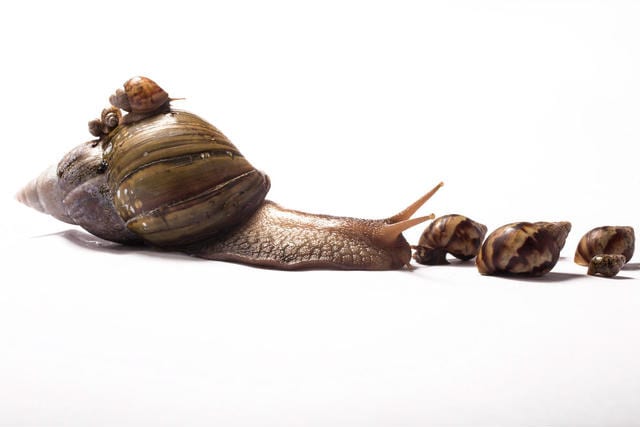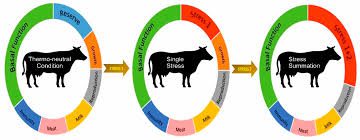Factors that affect African Land Snails Survival
Human activities constitute the largest threat, followed by climatic conditions that affect the snails’ biodiversity and population of snails in snail farming in a given region. They include:
– Deforestation i.e. the falling of trees for various purposes such as urbanization, road construction, building of industries, houses and schools.
– Use of pesticides, fertilizers, nematocides by crop farmers in weeds and nematode control in the farming.
The use of agro-chemicals such as pesticides in crop production also contributed in the change in the soil pH and the snail’s ecosystem and biodiversity.
– Slash and Burn agricultural practices of rural farmers during planting seasons. This displaces the snails in their natural habitat and exposes their eggs to harsh weather conditions such as sunlight and rain.
– Bush burning/ fires occasioned by the hunters of wild life animals e.g. bush meat.
– Population growth and demand for cheap sources of animal protein.
– Indiscriminate snail hunting in the forest (Ikojo et al., 2014).
– Lack of suitable foundation stock for large scale and commercial snail farming.
– Unavailability of commercial snail feeds and concentrates
Commercial and intensive crop production systems, which uses inorganic fertilizers as a source of soil nutrients supplementation for profitable crop production.
The use of inorganic fertilizers and compounds has destroyed the natural snail ecosystem and habitat suitable for snail growth, development and reproduction in their wild (Ikojo et al., 2014).
Climatic Factors Affecting African Land Snail Population in the Humid Tropics
Unfavorable climatic conditions and climate change poses a serious problem to snail population and farming in West African region. Climatic influence and its effects on snails have an associative effect on temperature, humidity, wind/air movement and light intensity.
Somethings about snail farming is that snails are susceptible to infections and diseases caused by environmental contamination’s and pollutants (Ebenso and Ologhobo, 2009).
Temperature: It is a major factor that influences the activities of snails. Snail requires lower and moderate temperature for normal feeding and body functions. Temperature ranges of between 23 – 28oc are suitable for snails’ growth and development. During hotter periods with high ambient environmental temperature, snails may experience heat stress.
Heat stress poses a serious economic threat to snails population and snails under domestication. According to Ariry (2014), the effect of heat occasioned by high temperatures on snails could be in the form of reduced feed intake and utilization, reduced egg production, reduce growth rate, low body weight, poor hatchability and fertility. Okafor (2001) stated that snails hibernates and aestivation especially during dry hot unfavorable seasons. Air, environmental and noise pollution’s (Ebenso and Ologhobo, 2009) affects snails.
Read Also: The Concept of Animal Production on Agriculture
Humidity: Snails enjoy moist and cooler environments, which is usually achieved when it rains, the atmospheric air become moist with high relative humidity. Snails are active at a relative humidity of between 70 – 90%.
However acidic rains in some areas caused by high air pollutants adversely affect snails’ population (Ojiako, 2006). If the air is drier and hot, for longer periods, snails may dry up and die or hibernate.
In snail farming business, snail pens and the top soils should be sprinkle with water regularly during hot periods especially in the dry seasons to maintain adequate damp environment (Ikechukwu, 2012).
Excessive air movement and winds: This is another climatic factor that may result in severe dehydration in snails and may cause them to retract into their shells, rather than feeding to gain weight and to breed.
Prolong periods may cause the snails to go into aestivation which is a period of inactivity or dormancy in the life of snails (Okafor 2001).
Light Intensity: Snail requires light for their activities such as feeding and breeding. Though snails are nocturnal animals, however they require light for some photo-biological processes essential in the energy level and food chain e.g. cellular digestion and photosynthesis (Ikechukwu, 2012).
Day light is usually from the sun, longer periods of light stimulate and prompt snails into reproduction under favorable conditions.
Soil Type: Snails depend very much on the soil for their food and reproduction e.g. egg laying. They can hardly survive or thrive effectively in the absence of a suitable soil-type.
They require moist, aerated, easily drained, non waterlogged and non acidic soils. Soil rich in minerals contents and organic matters are good as too soil for snail farming after being sterilized to kill pathogens in the soils (Ikechukwu, 2012).
Read Also: The Different Types of Fertilizers and How they Work
Predators of African Land Snails in the Humid Tropics
Giant African land snails are faced with the challenge of predator in their natural wild habitat, these predators pose a great danger to their normal growth and reproduction of snail production, if not checkmated may lead to the decline in population of snail biodiversity or extinction of various snail species in nature.
Predators mostly depend on their prey as a source of food for survival in the ecosystem. Snail predators feed on the snail species at their various stages of growth and maturity.
According to Akinnusi (2014), snail predators includes: Arthropods –Insects (termites, beetle, mites, moth, driver ants, carabid beetles, cockroaches and soldier ants); Crusteceans: – Millipedes, Centipedes, Cricket, Crabs and Forest Spider; Reptiles:- Lizards and Snakes, Amphibians:- frogs, turtles and toads; nematodes, Rodents: – mice and rats; Aves:- birds, crows, ducks and turkeys as well as Mammal:- man (Ikechukwu, 2012).
Diseases and Parasite affecting African Land Snails in the Humid Tropics
The common diseases affecting snails either in their wild or in their cultured environments even in a commercial snail farming system includes:
Fungal diseases mainly Fusarium Spp affects indigenous snail species native to West African region. They are susceptible this diseases causing agent. These diseases is commonly referred to as rosy eggs disease and the affect eggs turns reddish brown and die off (Akinnusi, 2014).
Parasites such as Alluaudihella Flavicornis are diseases vectors to snails both in their wild and under domestication.
Bacterial diseases caused by Pseudomonas Spp especially Pseudomonas aeruginosa causes intestinal infections in snail rearing. This disease affects snail’s normal growth and development processes.
Deficiency diseases, it occurs mostly in domesticated snails with poor feeding, as a result of lack of minerals nutrients especially calcium and phosphors. The affected snail’s shell turns white as a result of deficiency of calcium in their feeds over a longer period of time (Akinnusi, 2014).
Cannibalism: This mostly occurs in domesticated snails housed in pens. Older snails can eat, break the shells or fed on hatchlings as a source of nutrients especially calcium and water to avoid dehydration and for their survival. This occurs where snails are overcrowded and there is increased competition for food and space (Ikechukwu, 2012).
According to Okafor, (2001) and Akinnusi (2014), they stated that predators of snails inflict havoc on the snails by either breaking their shells, biting or sting the snails or eat them as food both their eggs and juvenile snails e.g. frogs and reptiles (Akinnusi, 2014).
Snail predators adversely affect the population of the native Giant African Land Snail species of West African origin and its biodiversity in snail rearing business.
Generally maintaining of high hygienic standards in snail farms will reduce the incidence of diseases and spread of diseases in the snail farms.
According to Walker et al., (1999), snails ingest micro-organisms e.g. bacteria from the soil and their environment, poor hygiene may predispose the snails to diseases and pathogens, which will affect their growth and reproduction.
Related: 7 Factors to Consider before Setting Up your Farming Business



